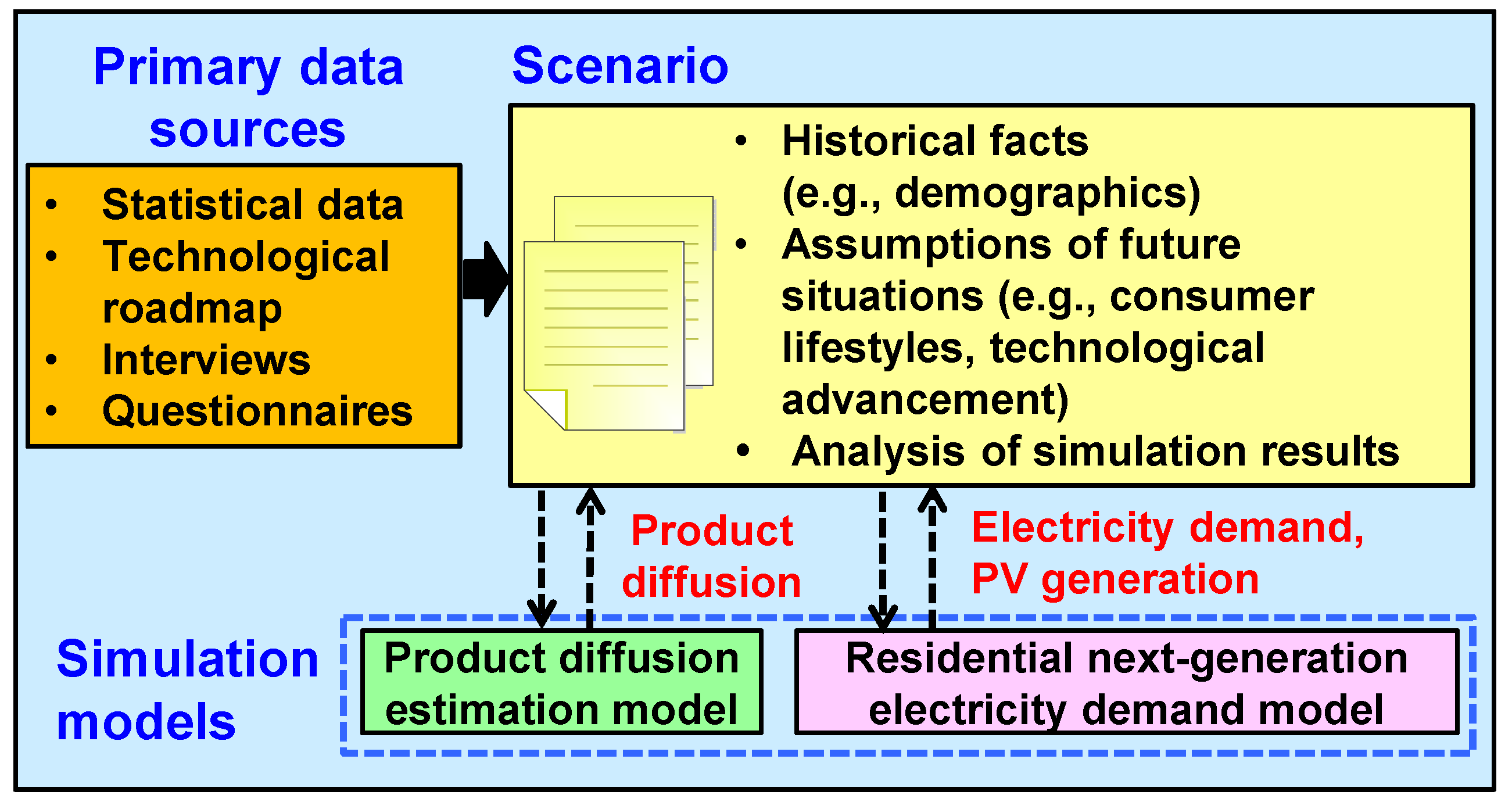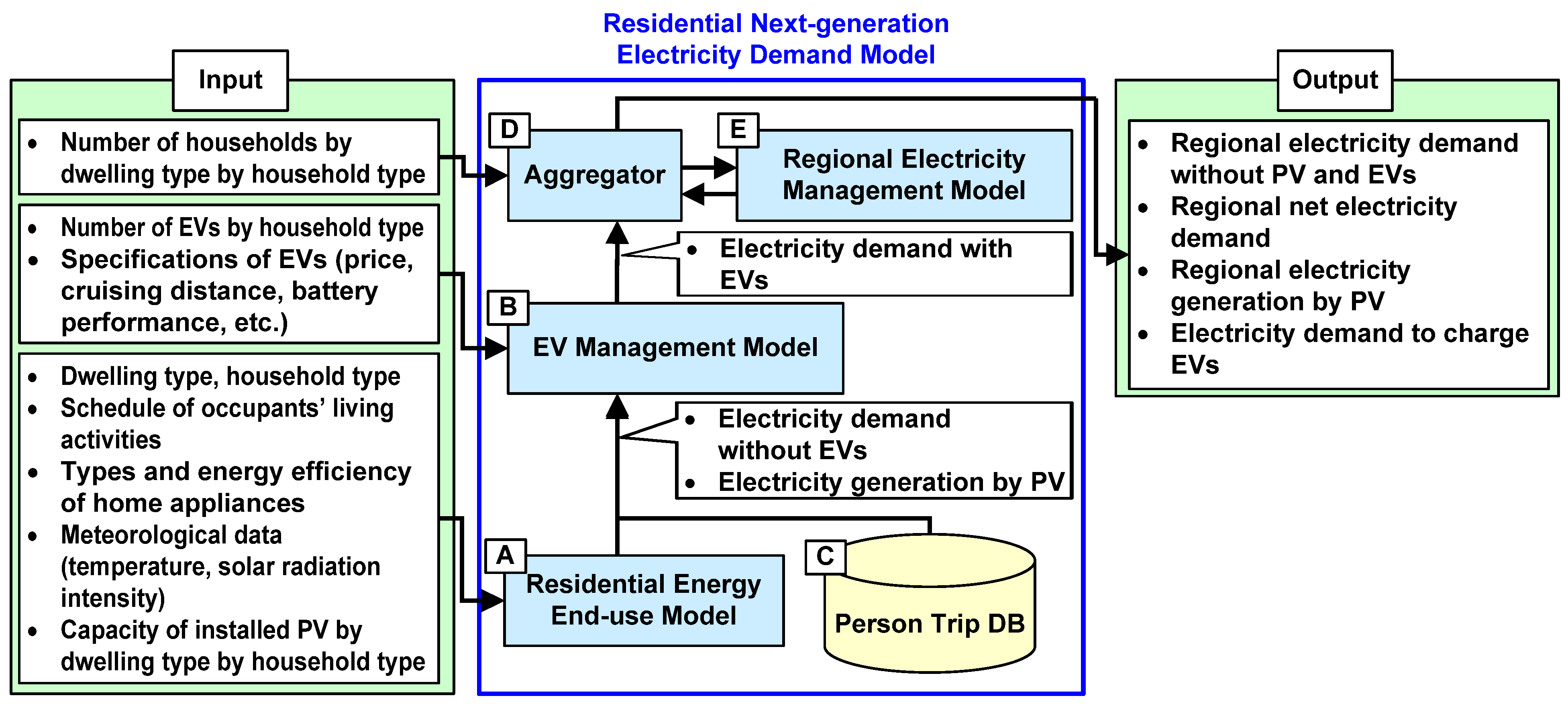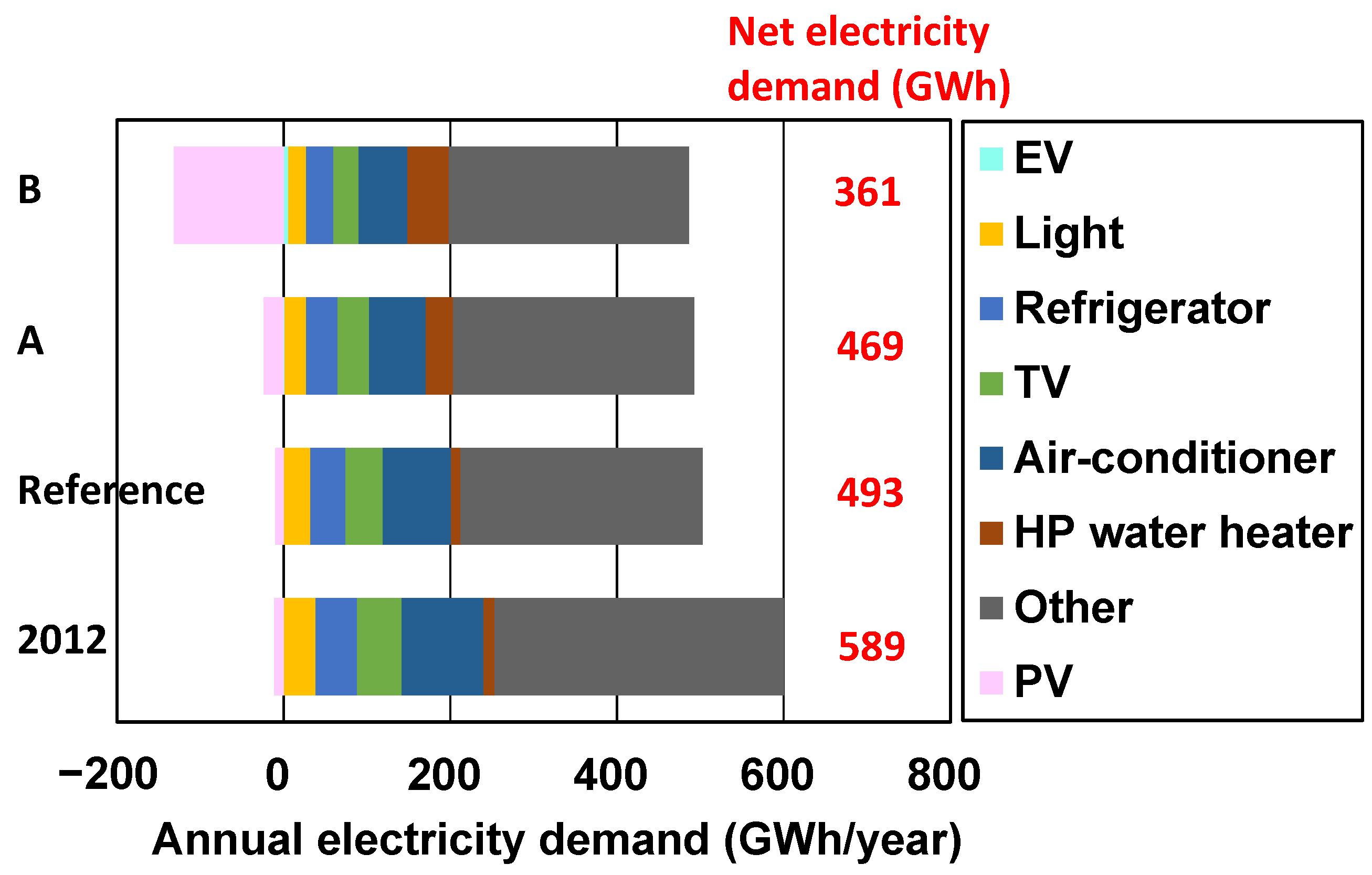Scenario Analysis of Electricity Demand in the Residential Sector Based on the Diffusion of Energy-Efficient and Energy-Generating Products
Abstract
:1. Introduction
2. Related Work on Residential Sector Electricity Demand
2.1. Related Studies
2.2. Problem Identification
3. Scenario Analysis for Estimating Residential Sector Electricity Demand
3.1. Approach
3.2. Residential Next-Generation Electricity Demand Model
- A.
- Residential Energy End-use Model [8]: This model calculates household electricity demand and PV power generation based on, e.g., family composition, dwelling type, weather conditions, and resident behavior, utilizing statistical data, measurements, and questionnaire survey results.
- B.
- EV Management Model: This model incorporates EV adoption and specifications (e.g., price, cruising distance, battery performance) to calculate household electricity demand, including EV charging.
- C.
- Person Trip Database: This database stores frequency distribution data for daily driving distances and times. In component (B), the stored data are used to determine the timing of charging and discharging EV batteries. This enabled the calculation of regional electricity demand for EVs.
- D.
- Aggregator: Calculates regional electricity demand by multiplying household electricity demand per unit by the number of households and the amount of PV power generated. Electricity demand with EVs per household is calculated by the above components (A)–(C).
- E.
- Regional Electricity Management Model: Utilizing EV usage patterns and person trips per household by referring to component (C), this model determines the optimal charging/discharging pattern for EV storage batteries to minimize peak daily net electricity demand in the region, considering both PV-generated electricity and household demand. In the case study section, this model is applied to Scenario B–M (see Figure 3).
3.3. Product Diffusion Estimation Model
- (1)
- Product choice forecasting model [26]
- (2)
- Appliance replacement model
4. Case Study: Scenario Analysis of Residential Sector Electricity Demand in Toyonaka City for 2030
4.1. Overview of the Case Study
4.2. Scenario Storylines and Assumptions
4.3. Estimation of the Energy-Efficient and Energy-Generating Product Diffusion Rate and Electricity Demand
5. Discussion
5.1. Key Findings from the Case Study
5.2. Methodological Contributions Relative to the Literature
5.3. Limitations
6. Conclusions
Author Contributions
Funding
Institutional Review Board Statement
Informed Consent Statement
Data Availability Statement
Acknowledgments
Conflicts of Interest
Appendix A
| Variable | Description |
|---|---|
| Product choice forecasting model | |
| Nsat | Maximum diffusion rate of new products |
| n(t) | Diffusion rate for Nsat at year t |
| p | Coefficient for innovators |
| r | Coefficient for imitators |
| Ui | Utility of consumer i |
| sj | Level of the attribute (preference factor) j |
| wij | Weighting factor for attribute j of consumer i |
| H(t) | Percentage of consumers i with a higher utility Ui of the new diffusing product compared to other competing products at year t |
| H(t0) | H(t) at the initial year |
| Appliance replacement model | |
| S(t) | In-use stock of products at year t |
| S(t0) | S(t) at the initial year |
| I(t) | Inflow of the product at year t |
| O(t) | Outflow of the product at year t |
| LT | Lifetime of the product |
| Item | 2012 | 2030 | Remarks | |
|---|---|---|---|---|
| Scenario A | Scenario B | |||
| Number of households (thousands) | 156,341 | 134,785 | [50] | |
| Number of passenger automobiles (-) | 87,430 | 86,081 | Assumed to decline from 2012 to 2030 in proportion to the number of households. | |
| Grid electricity price (JPY/kWh) | 26.3 | 31.0 | Data obtained from [51], assuming the nuclear power share in 2030 is 15%. | |
| PV installation cost (thousand JPY/kW) | 432 | 432 | 131 | PV installation cost in Scenario B decreases based on the technology roadmap [34]. |
| Initial cost of heat-pump water heater (thousand JPY/unit) | 820 | 550 | 410 | The initial cost in Scenario B decreases based on the technology roadmap [40]. |
| Lifetime of heat-pump water heaters, air conditioners, televisions, refrigerators (years) | 10 | Authors’ assumption by referring to [38]. | ||
| Lifetime of LED lights (year) | 20 | [37] | ||
| Lifetime of detached houses and apartments (years) | 45 (detached), 40 (apartments) | Refer to [36,39]. The lifetime of houses is used to calculate the diffusion of insulated panels. | ||
| Item | Average Values of Weighting Factor wij |
|---|---|
| PV | |
| Initial cost | −0.00329 (/thousand JPY) |
| Annual electricity cost savings | 0.02164 (/thousand JPY) |
| Warranty period | 0.0156 (/year) |
| EV | |
| Powertrain | 1.01 (gasoline vehicle), 0.64 (hybrid vehicle), 0.43 (plug-in hybrid vehicle), −2.08 (electric vehicle) |
| Initial cost | 0.0000498 (/thousand JPY) |
| Running cost | −0.000359 (/JPY/month) |
| Mileage | 0.00268 (/km) |

References
- Sagaria, S.; Duarte, G.; Neves, D.; Baptista, P. Photovoltaic integrated electric vehicles: Assessment of synergies between solar energy, vehicle types and usage patterns. J. Clean. Prod. 2022, 348, 131402. [Google Scholar] [CrossRef]
- Sun, C.; Zhao, X.; Qi, B.; Xiao, W.; Zhang, H. Economic and environmental analysis of coupled PV-energy storage-charging station considering location and scale. Appl. Energy 2022, 328, 119680. [Google Scholar] [CrossRef]
- Vilaça, M.; Santos, G.; Oliveira, M.S.A.; Coelho, M.C.; Correia, G.H.A. Life cycle assessment of shared and private use of automated and electric vehicles on interurban mobility. Appl. Energy 2022, 310, 118589. [Google Scholar] [CrossRef]
- Alcamo, J. Scenarios as tools for international environmental assessments. In Environmental Issue Report No. 24; Ribeiro, T., Ed.; European Environmental Agency: Copenhagen, Denmark, 2001. [Google Scholar]
- Kishita, Y.; Hara, K.; Uwasu, M.; Umeda, Y. Research needs and challenges faced in supporting scenario design in sustainability science: A literature review. Sustain. Sci. 2016, 11, 331–347. [Google Scholar] [CrossRef]
- Schwartz, P. The Art of the Long View; Doubleday: New York, NY, USA, 1991. [Google Scholar]
- Kishita, Y.; Kurahashi, N.; Yamaguchi, Y.; Shimoda, Y.; Fukushige, S.; Umeda, Y. Scenario design approach to envisioning regional electricity networks with photovoltaics and electric vehicles. In Proceedings of the International Conference on Engineering Design, Seoul, Republic of Korea, 19–22 August 2013. Paper #492. [Google Scholar]
- Shimoda, Y.; Yamaguchi, Y.; Okamura, T.; Taniguchi, A.; Yamaguchi, Y. Prediction of Greenhouse Gas Reduction Potential in Japanese Residential Sector by Residential Energy End-use Model. Appl. Energy 2010, 87, 1944–1952. [Google Scholar] [CrossRef]
- Tasaki, T.; Motoshita, M.; Uchida, H.; Suzuki, Y. Assessing the Replacement of Electrical Home Appliances for the Environment: An Aid to Consumer Decision Making. J. Ind. Ecol. 2013, 17, 290–298. [Google Scholar] [CrossRef]
- Higgins, A.; McNamara, C.; Foliente, G. Modelling Future Uptake of Solar Photo-voltaics and Water Heaters under Different Government Incentives. Technol. Forecast. Soc. Chang. 2014, 83, 142–155. [Google Scholar] [CrossRef]
- Drude, L.; Pereira, L.C.; Ruether, R. Photovoltaics (PV) and Electric Vehicle-to-grid (V2G) Strategies for Peak Demand Reduction in Urban Regions in Brazil in a Smart Grid Environment. Renew. Energy 2014, 68, 443–451. [Google Scholar] [CrossRef]
- Bartusch, C.; Alvehag, K. Further Exploring the Potential of Residential Demand Response Programs in Electricity Distribution. Appl. Energy 2014, 125, 39–59. [Google Scholar] [CrossRef]
- Betancourt-Torcat, A.; Charry-Sanchez, J.; Almansoori, A.; Alkatheri, M.; Flett, P.; Elkamel, A. An integrated electric vehicle network planning with economic and ecological assessment: Application to the incipient middle Eastern market in transition towards sustainability. J. Clean. Prod. 2021, 302, 126980. [Google Scholar] [CrossRef]
- Thakur, J.; de Almeida, C.M.L.; Baskar, A.G. Electric vehicle batteries for a circular economy: Second life batteries as residential stationary storage. J. Clean. Prod. 2022, 375, 134066. [Google Scholar] [CrossRef]
- Yu, Z.; Lu, F.; Zou, Y.; Yang, X. Quantifying the real-time energy flexibility of commuter plug-in electric vehicles in an office building considering photovoltaic and load uncertainty. Appl. Energy 2022, 321, 119365. [Google Scholar] [CrossRef]
- Kobashi, T.; Choi, Y.; Hirano, Y.; Yamagata, Y.; Say, K. Rapid rise of decarbonization potentials of photovoltaics plus electric vehicles in residential houses over commercial districts. Appl. Energy 2022, 306, 118142. [Google Scholar] [CrossRef]
- Zhang, N.; Lu, Y.; Chen, J.; Hwang, B.G. An agent-based diffusion model for Residential Photovoltaic deployment in Singapore: Perspective of consumers’ behavior. J. Clean. Prod. 2022, 367, 132793. [Google Scholar] [CrossRef]
- Olsson, J.M.; Gardumi, F. Modelling least cost electricity system scenarios for Bangladesh using OSeMOSYS. Energy Strategy Rev. 2021, 38, 100705. [Google Scholar] [CrossRef]
- Gebremeskel, D.H.; Ahlgren, E.O.; Beyene, G.B. Long-term electricity supply modelling in the context of developing countries: The OSeMOSYS-LEAP soft-linking approach for Ethiopia. Energy Strategy Rev. 2023, 45, 101045. [Google Scholar] [CrossRef]
- Quevedo, J.; Moya, I.H. Modeling of the dominican republic energy systems with OSeMOSYS to assess alternative scenarios for the expansion of renewable energy sources. Energy Nexus 2022, 6, 100075. [Google Scholar] [CrossRef]
- Dreier, D.; Howells, M. OSeMOSYS-PuLP: A stochastic modeling framework for long-term energy systems modeling. Energies 2019, 12, 1382. [Google Scholar] [CrossRef]
- Di Leo, S.; Caramuta, P.; Curci, P.; Cosmi, C. Regression analysis for energy demand projection: An application to TIMES-Basilicata and TIMES-Italy energy models. Energy 2020, 196, 117058. [Google Scholar] [CrossRef]
- Tash, A.; Ahanchian, M.; Fahl, U. Improved representation of investment decisions in the German energy supply sector: An optimization approach using the TIMES model. Energy Strategy Rev. 2019, 26, 100421. [Google Scholar] [CrossRef]
- Oshiro, K.; Fujimori, S.; Ochi, Y.; Ehara, T. Enabling energy system transition toward decarbonization in Japan through energy service demand reduction. Energy 2021, 227, 120464. [Google Scholar] [CrossRef]
- Yamaguchi, Y.; Shoda, Y.; Yoshizawa, S.; Imai, T.; Perwez, U.; Shimoda, Y.; Hayashi, Y. Feasibility assessment of net zero-energy transformation of building stock using integrated synthetic population, building stock, and power distribution network framework. Appl. Energy 2023, 333, 120568. [Google Scholar] [CrossRef]
- Matsumoto, M.; Kondoh, S.; Fujimoto, J.; Masui, K. A modeling framework for the diffusion of green technologies. In Management of Technology Innovation and Value Creation: Selected Papers from the 16th International Conference on Management of Technology; Sherif, M.H., Khalil, T.M., Eds.; World Scientific Publishing Company: Singapore, 2008; pp. 121–136. [Google Scholar]
- Fodhil, F.; Hamidat, A.; Nadjemi, O. Potential, optimization and sensitivity analysis of photovoltaic-diesel-battery hybrid energy system for rural electrification in Algeria. Energy 2019, 169, 613–624. [Google Scholar] [CrossRef]
- Liu, J.; Chen, X.; Yang, H.; Li, Y. Energy storage and management system design optimization for a photovoltaic integrated low-energy building. Energy 2020, 190, 116424. [Google Scholar] [CrossRef]
- Nurunnabi, M.; Roy, N.K.; Hossain, E.; Pota, H.R. Size optimization and sensitivity analysis of hybrid wind/PV micro-grids—A case study for Bangladesh. IEEE Access 2019, 7, 150120–150140. [Google Scholar] [CrossRef]
- International Energy Agency (IEA). Technology Roadmaps: Smart Grids; IEA Publications: Paris, France, 2011. [Google Scholar]
- National Renewable Energy Laboratory (NREL). Renewable Electricity Futures Study. 2023. Available online: https://www.nrel.gov/analysis/re-futures.html (accessed on 23 March 2023).
- Bass, F.A. New product growth model for consumer durables. Manag. Sci. 1969, 15, 215–227. [Google Scholar] [CrossRef]
- Kishita, Y.; Kurahashi, N.; Yamaguchi, Y.; Fukushige, S.; Umeda, Y. Describing and analyzing future scenarios of electricity systems based on low-carbon technologies. In Proceedings of the 22nd Japan Society of Mechanical Engineers Design and Systems Division Conference, Hiroshima, Japan, 26–28 September 2012; pp. 690–699. (In Japanese). [Google Scholar]
- New Energy and Industrial Technology Development Organization (NEDO). PV Roadmap (PV2030+). 2009. Available online: https://www.nedo.go.jp/content/100080327.pdf (accessed on 23 March 2023). (In Japanese).
- Iwai, N.; Kurahashi, N.; Kishita, Y.; Yamaguchi, Y.; Shimoda, Y.; Fukushige, S.; Umeda, Y. Scenario analysis of regional electricity demand in the residential and commercial sectors—Influence of diffusion of photovoltaic systems and electric vehicles into power grids. Procedia CIRP 2014, 15, 319–324. [Google Scholar] [CrossRef]
- Komatsu, Y. Life time estimations of Japanese buildings and houses at the years of 1997 and 2005. J. Archit. Plan. Environ. Eng. 2008, 72, 2197–2205. (In Japanese) [Google Scholar]
- Ministry of Economy, Trade and Industry (METI). Current Situation of LED Lighting Industry. 2012. Available online: https://www.meti.go.jp/committee/summary/0004296/pdf/001_05_00.pdf (accessed on 23 March 2023). (In Japanese).
- Ministry of the Environment (MOE). Environmental Conservation Effect by Promoting Reuse: Lifetime Extension Effects and Environmental Consequences through Consumer Surveys. 2011. Available online: https://www.env.go.jp/content/900532654.pdf (accessed on 23 March 2023). (In Japanese).
- Shima, H.; Hara, T.; Yoshida, Y.; Matsuhashi, R. Estimation of lifetime of buildings and prediction of generation of demolished concrete by proportional hazard model. J. Environ. Eng. 2003, 573, 87–94. (In Japanese) [Google Scholar] [CrossRef] [PubMed]
- Ministry of Economy, Trade and Industry (METI). Cool Earth: Energy Innovation Technology: Technology Development Roadmap. 2008. Available online: https://www8.cao.go.jp/cstp/tyousakai/hyouka/kentou/gas_sekitan/haihu2/sanko2-1_2.pdf (accessed on 23 March 2023). (In Japanese).
- Ministry of the Environment (MOE). Summary of Automobile Working Group. 2012. Available online: https://www.env.go.jp/council/content/i_05/900424322.pdf (accessed on 23 March 2023). (In Japanese).
- Kishita, Y.; Nakamura, Y.; Kegasa, A.; Hisazumi, Y.; Hori, T.; Fukushige, S.; Umeda, Y. Scenario Analysis of the Diffusion of Fuel Cells in the Residential Sector. Procedia CIRP 2014, 15, 294–299. [Google Scholar] [CrossRef]
- Kishita, Y.; Mizuno, Y.; Fukushige, S.; Umeda, Y. Scenario structuring methodology for computer-aided scenario design: An application to envisioning sustainable futures. Technol. Forecast. Soc. Chang. 2020, 160, 120207. [Google Scholar] [CrossRef]
- Kishita, Y.; Masuda, T.; Nakamura, H.; Aoki, K. Computer-aided scenario design using participatory backcasting: A case study of sustainable vision creation in a Japanese city. Futures Foresight Sci. 2023, 5, e141. [Google Scholar] [CrossRef]
- Chesser, M.; Hanly, J.; Cassells, D.; Apergis, N. The positive feedback cycle in the electricity market: Residential solar PV adoption, electricity demand and prices. Energy Policy 2018, 122, 36–44. [Google Scholar] [CrossRef]
- Moon, H.B.; Park, S.Y.; Jeong, C.; Lee, J. Forecasting electricity demand of electric vehicles by analyzing consumers’ charging patterns. Transp. Res. Part D Transp. Environ. 2018, 62, 64–79. [Google Scholar] [CrossRef]
- Vasseur, V.; Kemp, R. The adoption of PV in the Netherlands: A statistical analysis of adoption factors. Renew. Sustain. Energy Rev. 2015, 41, 483–494. [Google Scholar] [CrossRef]
- Agency for Resources and Energy. Survey on Energy-Saving Policy Analysis 2010FY “Current Status of Energy Consumption in Households”; Agency for Resources and Energy: Tokyo, Japan, 2011. (In Japanese) [Google Scholar]
- Kishita, Y.; Mizuno, Y.; Fukushige, S.; Umeda, Y. Describing electricity demand scenarios focusing on the diffusion of low-carbon technologies in 2030. In Proceedings of the EcoDesign 2015: 9th International Symposium on Environmentally Conscious Design and Inverse Manufacturing, Tokyo, Japan, 2–4 December 2015; pp. 899–905. [Google Scholar]
- National Institute of Population and Social Security Research. Japan’s Population Forecasting by Region; National Institute of Population and Social Security Research: Tokyo, Japan, 2013. (In Japanese) [Google Scholar]
- Energy and Environment Council. Alternatives of Energy and Environment. 2012. Available online: http://www.cas.go.jp/jp/seisaku/npu/policy09/pdf/20120629/20120629_1.pdf (accessed on 23 March 2023).





| Product | Product Diffusion in 2030 | Remarks | |
|---|---|---|---|
| Scenario A | Scenario B | ||
| PV | 65 MW (32%) | 124 MW (61%) | Calculated based on the cost payback time, which is assumed to be 7.4 years in Scenario A and 2.7 years in Scenario B [33]. Percentages in parentheses refer to percentages in detached houses. |
| Plug-in hybrid vehicle (PHV) | 7095 (8.3%) | 9711 (11.3%) | Calculated based on the market share by automobile type assumed by [41]. Percentages in parenthesis refer to the percentage of the number of automobiles owned. |
| Mid-size EV | 13,268 (15.5%) | 14,861 (17.3%) | |
| Heat-pump water heaters | 33,978 | 62,698 | Calculated based on the cost payback time, which is assumed to be 7 years in Scenario A and 3.5 years in Scenario B [40,42]. The diffusion rate in Scenario B is 74.1% in apartment houses and 80.2% in detached houses, respectively. |
| LED lights | 689,260 (86.5%) | 1,589,357 (100%) | Calculated based on the cost payback time of 3 years in Scenario A, while the diffusion rate in Scenario B is assumed to be 100% based on the policy target [37]. |
Disclaimer/Publisher’s Note: The statements, opinions and data contained in all publications are solely those of the individual author(s) and contributor(s) and not of MDPI and/or the editor(s). MDPI and/or the editor(s) disclaim responsibility for any injury to people or property resulting from any ideas, methods, instructions or products referred to in the content. |
© 2024 by the authors. Licensee MDPI, Basel, Switzerland. This article is an open access article distributed under the terms and conditions of the Creative Commons Attribution (CC BY) license (https://creativecommons.org/licenses/by/4.0/).
Share and Cite
Kishita, Y.; Yamaguchi, Y.; Mizuno, Y.; Fukushige, S.; Umeda, Y.; Shimoda, Y. Scenario Analysis of Electricity Demand in the Residential Sector Based on the Diffusion of Energy-Efficient and Energy-Generating Products. Sustainability 2024, 16, 6435. https://doi.org/10.3390/su16156435
Kishita Y, Yamaguchi Y, Mizuno Y, Fukushige S, Umeda Y, Shimoda Y. Scenario Analysis of Electricity Demand in the Residential Sector Based on the Diffusion of Energy-Efficient and Energy-Generating Products. Sustainability. 2024; 16(15):6435. https://doi.org/10.3390/su16156435
Chicago/Turabian StyleKishita, Yusuke, Yohei Yamaguchi, Yuji Mizuno, Shinichi Fukushige, Yasushi Umeda, and Yoshiyuki Shimoda. 2024. "Scenario Analysis of Electricity Demand in the Residential Sector Based on the Diffusion of Energy-Efficient and Energy-Generating Products" Sustainability 16, no. 15: 6435. https://doi.org/10.3390/su16156435






